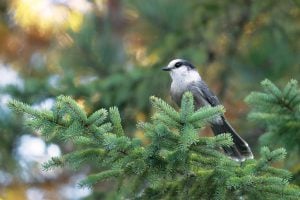Our prodigious brains can store vast amounts of information. London cab drivers, for example, must memorize the Knowledge, a set of famously grueling exams covering the location of 25,000 city streets. Not bad, but a Canada jay can cache up to 1,000 food items per day—then remember and retrieve upward of 100,000 of them over the course of a season.
Well before Western science arrived at these insights, people were aware of the exceptional qualities of corvids. These often loud and gregarious birds have played a significant role in human culture, serving as mythical and religious symbols. In parts of Europe, ravens are associated with the gods Apollo and Odin. In China, magpies are considered bringers of joy. In North America, among the Anishinaabe, the Canada jay is known as Gwiingwiishi and is considered a life-giver, a trick-player, and one of the smartest beings in Creation. It is also a jay of many names.
Lawrence Martin, former grand chief of the Mushkegowuk Council, grew up in Moose Factory, Ontario, hearing stories from his elders about wîskicahk, a Cree word anglicized as “whisky jack”—a name still in common use today. “It’s a sacred bird in many Cree communities,” Martin says. “One of the stories is about the bird providing itself to the Cree people when they were near starvation. It is a storyteller. It comes to warn you when misfortune is headed your way.”
“When you’re out on the land, hunting moose or chasing caribou, wîskicahk is there,” Martin says. “It follows you and makes you believe—gives you confidence—in what you are doing.” It knows that the hunters will be successful and that it will get the scraps. “And when you’re lost in the bush, you’ll ask the wîskicahk, ‘Where am I?’ All of the sudden, it will appear,” Martin adds. “It flies to the top of the tree, and it always faces the wind. The wind usually comes from the west. And this helps you get your bearings straight.”
European settlers, generally less enamored with corvids, bestowed at least 30 often-undignified monikers on this brilliant and extraordinary bird: camp robber, moose bird, venison hawk, and gorbey among them. Also known as the Canada jay since at least the 1830s, it was renamed the rather lackluster “gray jay” in 1957 by the American Ornithologists’ Union, as the American Ornithological Society (AOS) was then known. Strickland investigated why they had made the switch, found their arcane reasoning flawed, and politely petitioned the august body to change it back. In 2018, the AOS officially reinstated “Canada jay” as the accepted vernacular name of Perisoreus canadensis. Now, there’s a move afoot to have it declared Canada’s national bird.














